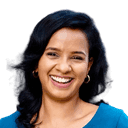Table of Contents
Table of Contents
- What Is Customer Journey Mapping?
- Why Is Customer Journey Mapping Important?
- Understand the Customer Experience to Map Their Journey
- What Should You Outline When Mapping a Customer Journey?
- When Should You Use More Than One Customer Journey Map?
- How to Create a Customer Journey Map
- Best Customer Journey Mapping Tools for Your Agency
- Go the Extra Mile by Customer Journey Mapping
7,000+ agencies have ditched manual reports. You can too.
Free 14-Day TrialQUICK SUMMARY:
Customer journey mapping is a method of detailing a customer's complete experience with a brand, from initial awareness to post-purchase interactions. This visual tool traces all touchpoints, identifying customer needs, perceptions, and challenges at each stage. This guide delves into the customer journey mapping process, covering how to track a customer's journey from the first interaction to lasting loyalty.
Consider this scenario (it’s one you’re likely familiar with). A client approaches your agency to run a social media campaign for a newly developed landing page. After a month of optimizing and tweaking, you’re pleased to report a successful campaign that racked up a ton of website clicks— woohoo!
Despite gaining social traction, your client is concerned that there aren’t very many people filling out the contact form. Even interested prospects fell off the radar when the sales team reached out.
After conducting an A/B test with a shorter landing page, it becomes apparent that customers aren’t engaged enough to scroll down to that ‘Contact Us!’ button. Your review of the call tracking dashboard also indicates a significant lag between the initial contact form and their sales team reaching out.
As a result, many prospects lost interest, a few forgot they filled out the contact form, and some even complained about their experience. We can almost hear that customer’s voice saying, ‘Are you kidding me? I filled that form out over a week ago!’
While completing a call to action is one way of tracking a conversion, there are several touchpoints a customer must go through when reaching out to your client for their product or service. Success isn’t just one outcome—it’s made up of connected, favorable results at each stage in the sales funnel, sometimes referred to as Micro Conversions.
If there are any blind spots, it will cost your client and affect their brand’s reputation. An excellent solution to this dilemma is creating a customer journey map.
This article will explore:
What Is Customer Journey Mapping?
Keeping track of the customer's experience at every touchpoint can get complicated, especially if there’s an intricate sales funnel.
That’s where a customer journey map will help.
A customer journey map is a visual outline that is created specifically for each agency client and gives a helpful representation of what their customers go through at every point of interaction with the brand. Its purpose is to clearly outline a customer’s experience from start to finish while also deciphering what they may be feeling at each stage.
An empathetic, data-driven approach through a customer journey map adds another dimension to your client’s marketing strategy. Not to mention it positions your agency as one that does its due diligence and goes the extra mile.
Why Is Customer Journey Mapping Important?
While mapping a customer journey may take a couple of brainstorming meetings and lots of subsequent edits, it’s definitely worth the hassle.
Successful digital marketing requires a good mix of combined skills. Many agencies spend too much time trying to figure what algorithms are doing that they lose focus on what people actually want. Our goal is to not only study the customer data, but to understand the customer journey. We then execute digital marketing campaigns for our clients based on a combination of data and customer personas.
Kevin Watts, President, Raincross
This exercise will help your client:
Improve retention while enhancing the customer experience
Minimize the time spent between each customer touchpoint
Target specific demographics through a tailored approach
Identify customer pain points and needs
Reduce turnaround and response time in the existing customer journey
Personalize their content marketing strategy based on the customer's experience
Ensure their customer service team is equipped to do their job effectively
Mapping out your client’s customer journey is a beneficial exercise for onboarding new customers and retaining brand loyalists (they’re often overlooked but also excellent resources to nurture).
Don’t let that untapped marketing potential slip through the cracks!
When we initially begin work with a client, we require a process that includes mapping their ideal customer journey. Through this mapping process, we identify areas of friction or fuel, and those lead to the development of different marketing opportunities.
Kerrie Luginbill, Chief Strategy Officer, OTM
Understand the Customer Experience to Map Their Journey
There are a few key questions to ask your client at the beginning stage of developing a customer mapping journey such as:
1. Why Are Prospects Searching for Your Business in the First Place?
Search intent comes into play here. By understanding the customer journey and what prospects are looking for, you’ll be able to infer their feelings and experiences. It's all about putting yourself in the customer's shoes.
For example, a prospect in the consideration phase may search for “lactose-free milk options.” While the term itself may not spell out the entire scenario, it’s possible that this prospect may be health conscious or managing a food allergy. This already ties into two target customer personas! Take it a step further by researching specific keywords and concerns for each prospect.
Exploring this question will feed into a customer journey map and contribute to your client’s SEO strategy. Now that’s a beneficial two-in-one customer persona exercise!
2. What Are Your Prospects’ Joy and Pain Points?
While this is a foundational marketing element, joy and pain points are often overlooked when all the marketing bells and whistles come into play. However, remember that tuning into your potential customers’ emotions affects everything in your client’s business, from product enhancements to branding and revenue.
Let’s take the example above. Prospects searching for “lactose-free milk options” may have entirely different experiences and feelings.
One potential customer’s pain point may be dealing with a food allergy, while another is full of hope and optimism (creating a healthy lifestyle). During the consideration phase, there will also be an element of uncertainty for many prospects (trying to make the best choice given a sea of options).
Based on this, you’ll better understand how each type of prospect navigates through their unique buyer’s journey. You may find that buyer personas spend different amounts of time at each stage of the sales funnel or may take different actions connected to your client’s brand.
This tailor-made customer journey mapping approach takes a bit more planning . However, it'll help you and your client to personalize marketing and understand the customer's perspective.
3. What Are Prospects’ Expectations When Engaging With Your Brand?
If prospects expect a phone call within a day of filling out a contact form, it’s not a good look to finally reach out weeks later. Not only does it reflect poorly on the response rate, but it will negatively affect prospects’ feelings towards the brand.
When considering prospects’ expectations, be sure to consider:
Turnaround time for contact points
Whether customer queries are answered adequately and authoritatively
Any gaps in internal staff training (e.g., product features, recommended certifications, answering frequently asked questions, escalating more complex queries)
How well your client’s content is performing
Agency Tip: Tracking organic traffic and using marketing analytics tools (including call tracking) come in handy when you’re evaluating your client’s brand performance. Use data-driven insights to make strategic decisions at each stage of the customer journey.
What Should You Outline When Mapping a Customer Journey?
A customer journey map may seem intimidating if your client’s business has many layers (such as a comprehensive product offering, a complex funnel, or a range of target markets).
However, as with most things, having a systemized approach will add structure and valuable insights. Before you even begin filling out a customer journey map, your client should decide on a distinct goal for the exercise. It won’t make sense to get ‘lost in the sauce’ by trying to fit too many complexities into one customer journey map.
Goals for customer journey maps range from increasing product purchases to developing a positive brand perception. Keep this goal at the forefront while doing this exercise to keep things on track.
Here’s what you should outline:
1. Demographic Details
When mapping out the customer, creating buyer personas for each type of customer helps your client understand their unique needs, goals, and experiences. As you know, it’s important to include key insights on age, interests, hobbies, occupation, and other influential details.
The reason for identifying the customer personas is that different demographics may follow a different path to purchase with your client. A middle-aged, suburban female may interact with your client’s brand completely differently than a Gen Z, urban male.
One customer may request more information via an online form or email, while the other might take to social media to pose their questions.
Focus on the ideal demographics for the client, not every possible demographic combination that might purchase. Trying to be all things to all people is, more often than not, a recipe for marketing disaster.
2. Emotions and Experiences at Each Point
As customers move through their journey, they’re likely feeling different emotions following certain actions and phases. Mapping this emotional journey will help you to empathize while addressing concerns at each customer touchpoint.
For example, a customer searching for a car insurance policy may feel excitement and angst after purchasing their first vehicle. During the conversion phase, their emotions may be a bit more settled as they’re guided through the process and eventually overcome that initial feeling of uncertainty.
Equipping your client with this type of insight will help improve the overall customer experience. The benefits of creating educational content to providing internal staff training on product FAQs are endless when you truly understand a prospect’s emotional state.
3. Sales Funnel Stages
We’re sure you know the sales funnel like the back of your hand! Understanding customer actions and experiences at each stage will help you to plan content, implement appropriate calls to action, and even streamline customer conversion paths.
To get the most out of customer journey mapping, use the sales funnel stages as an overarching theme when filling out a template. This will provide a practical structure and help you understand what’s happening at each stage (internally at your client’s company and externally for prospects).
That way, you provide your client with strategic and actionable recommendations every step of the way.
4. Key Performance Indicators at Each Stage
There are qualitative experiences to track during customer journey mapping. However, don’t forget the power of data-driven insights. KPIs will help you to create a narrative of what’s happening with customers at each stage.
For example, suppose you’ve noticed that the lead capture KPI from the landing page has significantly dropped, but there have been no changes made to that landing page. In that case, it’s likely an indication that something has changed in another part of the customer journey map, such as PPC keyword targeting, which should be explored further.
Tracking KPIs can also shed light on internal gaps. If your client includes a KPI for callback rates within an hour, it’s an area for improvement when their CRM data shows that the sales team typically reaches out after 24 hours.
Understanding the difference between KPIs and metrics will also help you to determine what works best as you map out those unique customer journeys. After all, you don’t want to present a myriad of metrics that don’t contribute to your client’s business goals.
5. Customer Actions at Each Touchpoint
Observing customer actions gives you an idea of where they’re in the sales funnel. It also provides insights used to tweak your client’s marketing strategy and create a more seamless user experience.
A customer watching an educational ‘how-to’ playlist on your client’s YouTube channel is likely at a different stage from one who’s a click away from purchasing an online product.
At these touchpoints, you can market in distinctive and relatable ways, personalizing the customer experience. It’ll also help you to understand the flow of customer actions and strategically meet your client’s business goals.
6. Existing and Possible Pain Points
While some prospects are experiencing pain points and actively looking for a solution, others may not be actively searching for your client’s product or service (yet). It’s still an opportunity to position your client’s brand as a preferred option if a prospect converts later on or even refers someone else.
Identifying pain points enhances the customer experience through empathy and provides a solution. Use this insight to create impactful content while also sensitizing your client’s staff to the reality of what customers are experiencing.
Not only does this humanize your client’s brand, but it also fosters a sense of trust.
7. Areas for Improvement
Continuous improvement is the way to go when enhancing the customer experience. No sales cycle is perfect, so discussing and evaluating any shortcomings is important. After all, you can’t fix what you don’t know.
Incorporating a customer feedback loop as part of your client’s strategy is a great idea, enabling them to improve processes. This can include engagement (such as inviting prospects to interact with content on social media), filling out feedback forms, or even conducting focus groups with more seasoned customers.
By regularly revisiting the customer journey, we can proactively adapt to market shifts and offer our clients opportunities that enhance our overall engagement with them, while aligning with their needs and the needs of their customers.
Kerrie Luginbill, Chief Strategy Officer, OTM
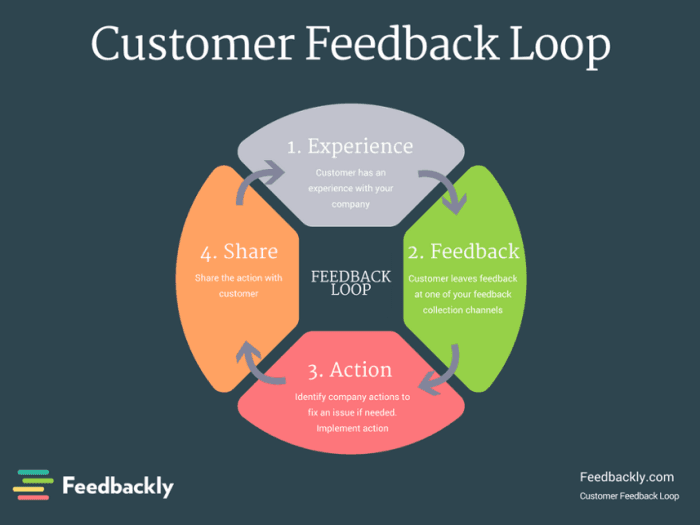
Hearing the customer’s voice will help you fill gaps and address their concerns directly. It also shows that your client’s brand is committed to a seamless customer experience.
Agency Tip: Ask your client to have regularly scheduled chats with their sales team, as this is an invaluable resource for customer feedback. Social media coordinators, account executives, and office managers who regularly respond to inquiries can also provide insights that might otherwise be overlooked.
When Should You Use More Than One Customer Journey Map?
You may find opportunities to create customer journey maps for different demographics, life experiences, and other characteristics, even if they’re similar scenarios.
Some practical examples include:
The buying journey of a first-time homeowner versus an experienced real estate investor
A 20-year-old exploring life insurance options versus a 45-year-old
A business owner shopping for office furniture versus a remote worker with a home office
In these cases, prospects will have entirely distinct experiences, and they’ll navigate differently. Therefore, it makes sense to have separate customer journey maps better to understand each prospect’s unique customer experience and needs.
As you can see, there’s a bit of groundwork to cover. The good news is that it’ll set you up for customer journey mapping success!
How to Create a Customer Journey Map
As we’ve described, a customer journey map is a highly personalized tool with variations across clients and their unique customers. While tailoring this map is recommended, there are a few general guidelines that will have cross-functional benefits for many different situations.
Here’s a quick, handy customer journey map template with examples to reference.
| Awareness | Consideration | Conversion | Brand Loyalty |
|---|---|---|---|---|
Ask Yourself | Although they may not be searching for a product or service yet, is there a pain point my prospects may experience in the future? | What would help solve any uncertainty, differentiate my client’s brand, and reiterate a unique selling proposition? | How will my client quell anxiety and reassure prospects they’ve made the right decision? | How will my client nurture positive emotions, show appreciation and incentivize brand loyalists? |
Prospects' Experiences and Emotions | Indifference, curiosity | Indecisiveness, information gathering | Resolution, decisiveness, excitement, anxiety | Pride, affiliation, advocacy, attachment |
Customer Actions Taken | Watching videos/tutorials, visiting social media page | Visiting your client’s website, reaching out via messenger platforms | Fulfilling an online payment, signing up for an event, downloading an app | Leaving business reviews/ testimonials, referring new leads |
KPI Examples | Number of video views and impressions
| Number of new website visits, number of messages received | Number of payments received, event sign-ups, or app downloads | Number of business reviews or referrals received |
How Customer Feedback Is Gathered | Inviting prospects to interact with content (i.e., social media reactions, polls) | Using chatbots to learn more about their concerns and inquiries | Touching base directly via e-mail or phone call to offer assistance | Sending out customer satisfaction surveys. Be sure to survey customers at regular intervals |
Best Customer Journey Mapping Tools for Your Agency
Managing all those agency accounts is no easy feat—we get it! If you’re short on time but want to go above and beyond for your clients, here are a few tools to explore, along with their customer journey mapping examples.
1. UXPressia
This online tool does a great job of creating a customer journey map in a neat, simple format. UXPressia also offers customer journey map templates for various industries if you’ve got a wide range of clients, which can save some time. The storyboard feature also adds a bit of personality and emotive visual representation.
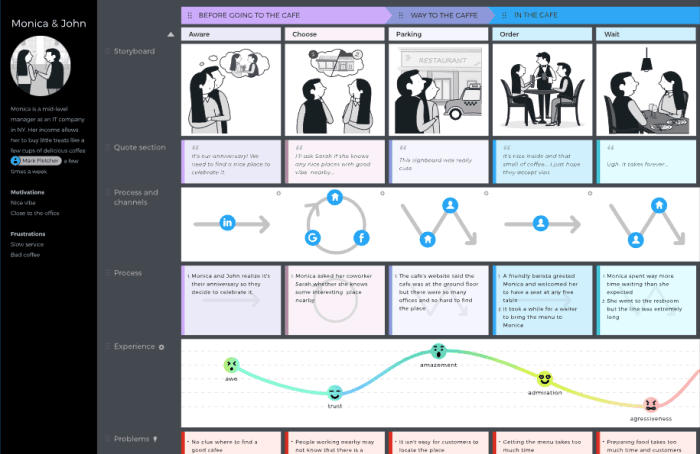
2. PowerPoint & Google Slides
If you’d like to keep things streamlined and not get lost in using too many platforms, consider PowerPoint or Google Slides to create customer journey maps.
With a range of elements, shapes, and artwork to choose from, it’s relatively simple to create a highly visual customer journey map. Plus, there’s an abundance of online customer journey map templates to choose from if you’d like to fill in details quickly and easily.
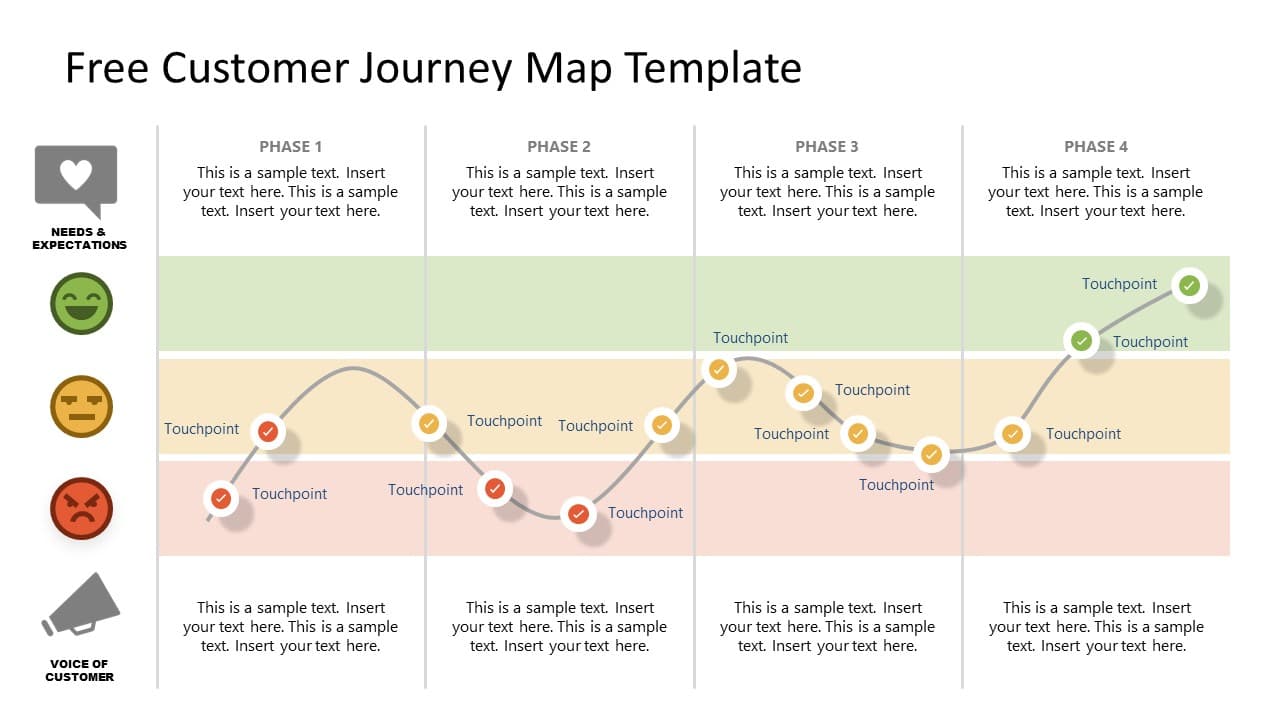
3. Gliffy
This neat online tool allows you to build customer journey maps with click-and-grab elements that resemble a more sophisticated flow chart. This may come in handy if you’ve got clients with more complex sales funnels or layers to fill in.

4. Custellence
This is another great online tool developed specifically for creating customer journey maps. The interface is quite intuitive and user-friendly with drag-and-drop elements.
Custellence is also highly collaborative, which is a huge plus if you’ve got multiple team members working on an agency account.
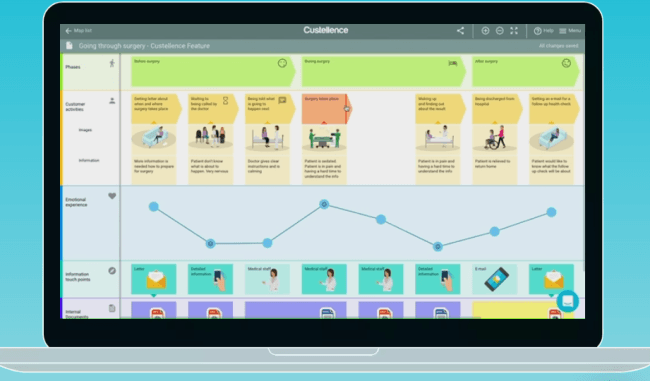
5. Adobe InDesign
If your agency already uses Adobe Creative Suite, then InDesign is an excellent choice for creating a customer journey map.
From customizable colors to utilizing unique shapes, this platform is a powerful one. Like other Adobe Creative Suite platforms, InDesign has many advanced capabilities.
This option is great if you’ve got an in-house, dedicated graphic design team to assist in the development of a more sophisticated customer journey map.
Go the Extra Mile by Customer Journey Mapping
Set your clients up for success by helping them understand their customers better. It may require a bit more time and effort to get the mapping done correctly but it’ll have a positive snowball effect on all your client’s marketing efforts.
Not only does customer mapping lead to a positive return on ad spend, but it can also help your agency get more clients.
Slow and steady is the name of the game– map customer journeys correctly and reap the benefits over time!
A robust reporting platform like AgencyAnalytics gives your agency the power to track multiple points in a prospect's journey on a single platform, which will help inform the journey mapping workflow. From Google Analytics to call tracking metrics to CRM and eCommerce data, tracking those key metrics is also an essential part of the process.
Creating white labeled customized reports has never been easier. Try AgencyAnalytics free for 14 days– no credit card required!

Written by
Faryal Khan is a multidisciplinary creative with 10+ years of experience in marketing and communications. Drawing on her background in statistics and psychology, she fuses storytelling with data to craft narratives that both inform and inspire.
Read more posts by Faryal KhanSee how 7,000+ marketing agencies help clients win
Free 14-day trial. No credit card required.


